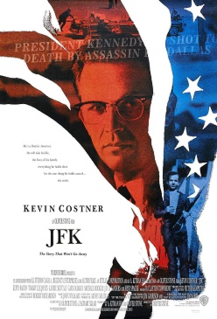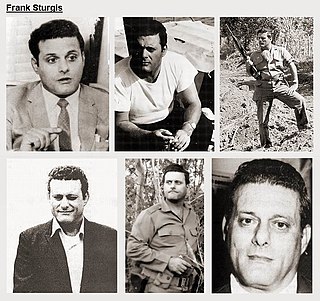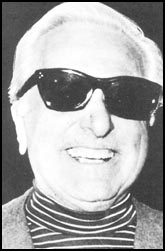
Lee Harvey Oswald was a U.S. Marine veteran who assassinated John F. Kennedy, then president of the United States, on November 22, 1963.

JFK is a 1991 American epic political thriller film that examines the events leading to the assassination of John F. Kennedy in 1963 and alleged cover-up through the eyes of former New Orleans district attorney Jim Garrison. Garrison filed charges against New Orleans businessman Clay Shaw for his alleged participation in a conspiracy to assassinate Kennedy, for which Lee Harvey Oswald was found responsible by the Warren Commission.

James Carothers Garrison was the District Attorney of Orleans Parish, Louisiana, from 1962 to 1973. A member of the Democratic Party, he is best known for his investigations into the assassination of President John F. Kennedy and prosecution of New Orleans businessman Clay Shaw to that effect in 1969, which ended in Shaw's acquittal. The author of three books, one became a prime source for Oliver Stone's film JFK in 1991, in which Garrison was portrayed by actor Kevin Costner, while Garrison himself also made a cameo as Earl Warren.

Frank Anthony Sturgis, born Frank Angelo Fiorini, was one of the five Watergate burglars whose capture led to the end of the presidency of Richard Nixon. He served in several branches of the United States military and in the Cuban Revolution of 1958, and worked as an undercover operative for the Central Intelligence Agency.

Everette Howard Hunt Jr. was an American intelligence officer and author. From 1949 to 1970, Hunt served as an officer in the Central Intelligence Agency (CIA), particularly in the United States involvement in regime change in Latin America including the 1954 Guatemalan coup d'état and the 1961 Bay of Pigs invasion. Along with G. Gordon Liddy, Frank Sturgis, and others, Hunt was one of the Nixon administration "plumbers", a team of operatives charged with identifying government sources of national security information "leaks" to outside parties. Hunt and Liddy plotted the Watergate burglaries and other clandestine operations for the Nixon administration. In the ensuing Watergate scandal, Hunt was convicted of burglary, conspiracy, and wiretapping, eventually serving 33 months in prison. After release, Hunt lived in Mexico and then Florida until his death.

Santo Trafficante Jr. was among the most powerful Mafia bosses in the United States. He headed the Trafficante crime family and controlled organized criminal operations in Florida and Cuba, which had previously been consolidated from several rival gangs by his father, Santo Trafficante Sr.

John"Handsome Johnny"Roselli, sometimes spelled Rosselli, was an influential mobster for the Chicago Outfit who helped that organization control Hollywood and the Las Vegas Strip. In the early 1960s, Roselli was recruited by the Central Intelligence Agency (CIA) in a plot to assassinate Cuban leader Fidel Castro.

Theodore George "Ted" Shackley, Jr. was an American CIA officer involved in many important and controversial CIA operations during the 1960s and 1970s. He is one of the most decorated CIA officers. Due to his "light hair and mysterious ways", Shackley was known to his colleagues as "the Blond Ghost".

The Cuban Project, also known as Operation Mongoose, was an extensive campaign of terrorist attacks against civilians, and covert operations, carried out by the U.S. Central Intelligence Agency in Cuba. It was officially authorized on November 30, 1961 by American President John F. Kennedy. The name Operation Mongoose had been agreed at a prior White House meeting on November 4, 1961. The operation was run out of JM/WAVE, a major secret United States covert operations and intelligence gathering station established a year earlier in Miami, Florida, and led by United States Air Force General Edward Lansdale on the military side and William King Harvey at the CIA and went into effect after the failed Bay of Pigs Invasion.
David Atlee Phillips was a Central Intelligence Agency officer of 25 years and a recipient of the Career Intelligence Medal. Phillips rose to become the CIA's chief of operations for the Western hemisphere. In 1975 he founded the Association of Former Intelligence Officers (AFIO), an alumni association comprising intelligence officers from all services.

The Central Intelligence Agency, known informally as the Agency and historically as the Company, is a civilian foreign intelligence service of the federal government of the United States, officially tasked with gathering, processing, and analyzing national security information from around the world, primarily through the use of human intelligence (HUMINT) and performing covert actions. As a principal member of the United States Intelligence Community (IC), the CIA reports to the Director of National Intelligence and is primarily focused on providing intelligence for the President and Cabinet of the United States. President Harry S. Truman had created the Central Intelligence Group under the direction of a Director of Central Intelligence by presidential directive on January 22, 1946, and this group was transformed into the Central Intelligence Agency by implementation of the National Security Act of 1947.

On March 1, 1967, New Orleans District Attorney Jim Garrison arrested and charged New Orleans businessman Clay Shaw with conspiring to assassinate President Kennedy, with the help of Lee Harvey Oswald, David Ferrie, and others. On January 29, 1969, Shaw was brought to trial in Orleans Parish Criminal Court on these charges. On March 1, 1969, a jury took less than an hour to find Shaw not guilty. It remains the only trial to be brought for the assassination of President Kennedy.
The John F. Kennedy assassination and the subsequent conspiracy theories surrounding it have been discussed, referenced, or recreated in popular culture numerous times.
Gerald Patrick "Gerry" Hemming, Jr. was a former U.S. Marine, mercenary and Central Intelligence Agency asset within the Domestic Contact Division beginning in 1960, using the aliases Jerry Patrick, Gerry Patrick, Heming and Hannon. He was primarily involved in covert operations against Cuba.
William King Harvey was a Central Intelligence Agency officer, best known for his role in the terrorism and sabotage campaign known as Operation Mongoose. He was known as "America's James Bond", a tag given to him by Edward Lansdale.

Salvatore Mooney Giancana was an American mobster who was boss of the Chicago Outfit from 1957 to 1966.
The CIA Kennedy assassination theory is a prominent John F. Kennedy assassination conspiracy theory. According to ABC News, the Central Intelligence Agency (CIA) is represented in nearly every theory that involves American conspirators. The secretive nature of the CIA, and the conjecture surrounding high-profile political assassinations in the United States during the 1960s, has made the CIA a plausible suspect for some who believe in a conspiracy. Conspiracy theorists have ascribed various motives for CIA involvement in the assassination of President Kennedy, including Kennedy's firing of CIA director Allen Dulles, Kennedy's refusal to provide air support to the Bay of Pigs invasion, Kennedy's plan to cut the agency's budget by 20 percent, and the belief that the president was weak on communism.

The assassination of John F. Kennedy on November 22, 1963, and the murder of Lee Harvey Oswald by nightclub owner Jack Ruby spawned numerous conspiracy theories. These theories allege the involvement of the CIA, the Mafia, Vice President Lyndon B. Johnson, Cuban Prime Minister Fidel Castro, the KGB, or some combination of these entities. The original FBI investigation and Warren Commission report, as well as an alleged "benign CIA cover-up", have led to the claim that the federal government deliberately covered up crucial information in the aftermath of the assassination. Former Los Angeles District Attorney Vincent Bugliosi estimated that a total of 42 groups, 82 assassins, and 214 people had been accused at one time or another in various conspiracy scenarios.

The United States' Central Intelligence Agency made numerous unsuccessful attempts to assassinate Fidel Castro during his time as the president of Cuba.

Rolando Cubela Secades is a Cuban revolutionary leader who played a vital part in the Cuban Revolution, being a founder member of the Directorio Revolucionario Estudantil and later the military leader of the DRE's Escambray Mountain front, achieving the rank of Commander, the highest military rank in the Revolutionary Army. After the Revolution succeeded in 1959, Cubela became Cuba's envoy to UNESCO. Under the cryptonym AM/LASH, Cubela became "an important asset" of the Central Intelligence Agency, and worked with them on plots to assassinate Fidel Castro. In 1966 Cubela was arrested for plotting the assassination of Castro, and sentenced to twenty-five years in prison. Released in 1979, he went into exile in Spain.














